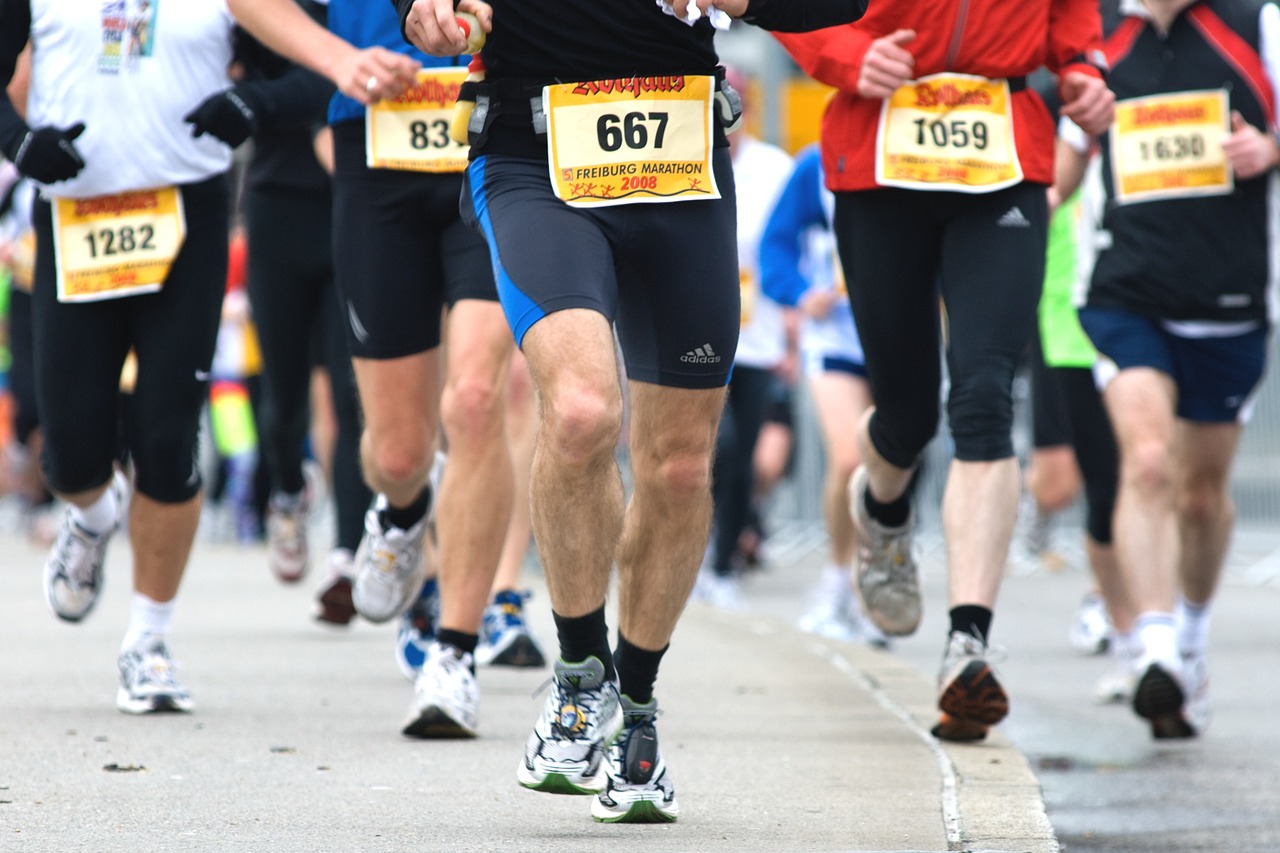Now that you have our tips and tricks on what to prepare before for your first run, you are now ready to begin training for your half-marathon! The second part of this half-marathon blog series will go over different factors to consider during training, including the differences between training alone and with others, nutrition, and the importance of training schedules.
The Importance of Training Plans

Finding a training plan that works with your schedule, preferences, and skill level is important as it can impact your engagement with, and ability to follow, day-to-day workouts. They are especially beneficial because they provide different types and intensities of training each week, and can help lower the risk of over training and injury.
Consistency is crucial when it comes to training for a half-marathon. Each time you run, your body is adapting to the gradual increase in distance and stress of running on your body. For example, your heart health and performance can be affected when you stop running or exercising for a few weeks. Therefore, maintaining your training – even a small amount – can offset these losses.
However, do not fret! Although it might take a bit of experimenting, training plans are versatile and can be adapted to what works for you and your body. I have provided links to a few training plans below that are categorized to fit the skill level and experience of the runner. However, I recommend giving each one a read so you can determine where you are most comfortable to start.
Training Plans for Beginners
- This program is a great place to begin if individuals do not have any experience running longer distances. It is 9 weeks in length and trains individuals to run 5km or 30 minutes without stopping.
- This 12-week program is designed for individuals who plan on running and walking the half-marathon. Training is geared to prepare you for alternate intervals of running and walking during the race.
Beginner Runner Training Schedule
- This is a basic 12-week program designed for individuals who plan on running the entire half-marathon. It is recommended that individuals have at least 2 months of running experience, and can run approximately 12km in total per week.
Lululemon Seawheeze Training Guide
- When I was training for my first half-marathon (which was the Seawheeze!), I followed Lululemon’s 14-week training guide. What I preferred most about this training plan was that it emphasized running for time versus running for distance in the first few weeks of training. Running for time (e.g. running for 20 minutes) meant that I could focus on my endurance and lasting the entire run rather than achieving a goal distance. For me, seeing a number (e.g. running 10km) made me nervous, especially since I had never run such a long distance before!
Training Plans for Intermediate Runners
If you have already ran a half-marathon before, and you have the goal of beating your previous time, this 12-week training guide may be right for you. Runners should be running 30 to 60 minutes a day, 4 to 5 days a week before starting this plan
A tool that can help set a realistic and achievable running time goal is a race time predictor. It allows you to input previous race times of varying running distances, and shows the approximate time it takes to complete your goal distance.
Training Plans for Advanced Runners
Already a seasoned runner? If you are trying to set and run a new personal record, this 12-week training guide may be right for you. Runners should be running approximately 5 days per week, and be comfortable running 12km or more during one session before starting this plan.
What to Eat Before and After a Run

You have chosen a training plan that works with your schedule, preferences, and skill level. Another factor to consider is your nutrition before and after your training.
Before a Run
Timing when you eat before your run is just as important as the types of foods you decide to consume. This differs from person to person, as some individuals can start running 15-20 minutes after they eat, whereas others might take 1-2 hours before they feel comfortable enough to run. Individuals will have to experiment and find out what time increment works for them.
Experimenting and finding foods that sit well in your stomach are important as well, as it can provide knowledge into what foods you should or should not eat before your race day. In general, you should avoid foods that are fatty or high in fiber – these take longer to digest. Instead, foods that have a good combination of carbohydrates and protein can help you feel more full.
The nutritional demand of your run is also an indicator of what foods you should consume before your workout. Depending on the intensity of your workout, your pace, and your effort expended, you may need to adjust the amount of food you eat. A calories burned running calculator can provide an indication of how many calories an individual should consume before their run.
After a Run
Sports dietitian Torey Armul suggests that best type of food to eat after a workout contains protein, since it is a nutrient that is crucial for muscle recovery and repair. In addition, it is also important to replenish glucose stores with carbohydrates, and stay hydrated to replenish fluid and electrolytes that are lost when sweating. Drinking the right fluids and having a post-workout meal that contains both carbohydrates and protein can make a difference in your performance and recovery.
Click here for examples of types of foods recommended by nutritionists and health coaches prior to and after your run. In addition, here are tips and tricks for how to hydrate before and after a run.
Training Alone versus With Others
According to Michelle Maidenberg, a psychotherapist working with athletes, a mixture of training alone and training with others can make you a more balanced runner.
Running alone can be a meditative experience. It is similar to hitting the mute button: individuals can concentrate and clear your mind, or zone out. This allows runners to strengthen their mental aspect of training. They can be more attentive of their form, breathing, pace, and notice when their body needs hydration or fuel.

An advantage of running with a partner or a group is accountability. Some days we might feel tired, stressed, or overwhelmed with work. However, if we know that someone is waiting for us, we will have more motivation to complete the run. This is a phenomenon known as social facilitation. For example, when you run with other people, you tend to put in more effort. Running with a partner or group can also expose individuals to different training methods and workouts. Vancouver has various running groups, such as The Running Room and MEC.
What Should I Do if I Get Injured?
Even if we follow our training plan, and avoid dangerous situations, unexpected injuries can still occur. Should you keep running if you are injured? Most running coaches say that it is better to get to the end of your training plan in a healthy state than to overwork your body and be in a state where you can’t run the actual race. If your injury prevents you from running without pain or discomfort, taking the time to rest and recover is just as beneficial.
Instead, you can change the type of workout you do. For example, if you are unable to run, try weight training or swimming (a low-impact activity that is easy on the joints). Avoid stopping physical activity completely during your recovery!
Outdoor Running Locations
If you are like me, running on a treadmill can feel stagnant. Of course, if weather conditions are unsuitable for running outside, having access to a treadmill can make your workouts more convenient, and help ensure that you remain consistent with your training plan. However, with spring weather finally approaching, here are some of my favourite locations to run when I need a change of scenery, fresh air, and sunshine:

- Stanley Park Seawall (10km)
- Iona Beach Regional Park (5km)
- Burnaby Central Park Terry Fox Trail (5km)
- Pacific Spirit Park (10km)
- Trout Lake Loop (10km)
- West Dyke Trail (6km)
Running Events in Vancouver
If you are a first-time half-marathon runner, and you have never participated in a running event before, it can seem overwhelming to jump into it without experience. In hopes to provide exposure for newer runners to a race environment, I have put together a list of running events around Vancouver that are shorter in distance. Individuals can also set these events as smaller goal distances and times they want to reach before their half-marathon.
- Vancouver Sun Run: 10km
- MEC Greater Vancouver Trail/Road Race: 5km, 9km, 10km, 15km
- Big Easter Run: 1-3km, 5km, 10km
- BMO Vancouver Marathon: 8km, Relay (5km, 12km, 13km)
- Run Canada Day: 5km, 10km

Are you ready to conquer half-marathons like the BMO Vancouver Half-Marathon or Lululemon’s SeaWheeze Half-Marathon? Stay tuned for tips and tricks on what to prepare before race day.

May Guan – Client Care Manager/Cardio Trainer
May developed her passion for fitness from participating in multiple sports at a young age – eventually finding her love for both playing and coaching volleyball. She is also an avid hiker and distance runner, and is always in search of a new challenge. May believes in fostering a fun, inclusive, and supportive environment where people can achieve their health-related goals.







